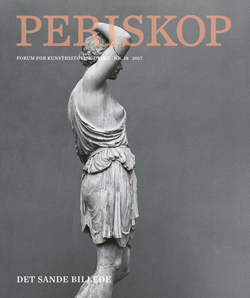Farven vender tilbage. Et “sandere billede” af antik skulptur
DOI:
https://doi.org/10.7146/periskop.v15i18.105150Resumé
The Re-Emergence of Colour. A “Truer Picture” of the Sculpture of Classical Antiquity
Though often held to be a well-known fact, the consequences of the re-emergence of polychromy of ancient Greek and Roman sculpture have not yet made themselves noticeably felt in the practice of disciplines most affected, namely classical archaeology and art history. Yet it challenges what we have long held to be “the true picture” of classical sculpture, as well as ideas on the aesthetics of later European sculpture. The absence of studies of the aesthetic dimension of polychrome sculptures of these later periods is remarkable. An outline of views on the aesthetics of the portrait of Nefertiti, a world famous masterpiece of ancient Egyptian polychrome sculpture, is followed by sections dealing in chronological order with some of aspects of how polychromy affects the picture we have of Greek and Roman sculpture. The relatively recent recognition of the unity of form and colour in Archaic sculpture is discussed on the background of the reception of the period; similarly, the unity of the sensuality of polychromy with ideal forms is the theme of the Classical section. In archaeology and art history, academic taxonomies of sculpture are established on the basis of materials, formats and dimensionalities. The advent of polychromy creates a continuum across these categories, in all periods, but is most clearly to be traced in the Hellenistic. In Roman sculpture, “copies” of Greek originals have for some time been the subject of increasingly varied, positive appreciation. The term “copy” is therefore being replaced by others, reflecting the “originality” of the contribution made by the Roman sculptors. To this can now be added that of the sculpture painter, leading to a whole new set of research questions. Were identical copies similar in their polychromy as well? This touches on the concept of “copy” and “original” in a Greek and Roman context. A final section reflects briefly on how this affects “true pictures” of later European sculpture and architecture.
Downloads
Publiceret
Citation/Eksport
Nummer
Sektion
Licens
Copyright (c) 2018 Forfatteren og Periskop

Dette værk er under følgende licens Creative Commons Navngivelse (by).
Forfattere, der publicerer deres værker via dette tidsskrift, accepterer følgende vilkår:
- Forfattere bevarer deres ophavsret og giver tidsskriftet ret til første publicering, samtidigt med at værket 12 måneder efter publiceringen er omfattet af en Creative Commons Attribution-licens, der giver andre ret til at dele værket med en anerkendelse af værkets forfatter og første publicering i nærværende tidsskrift.
- Forfattere kan indgå flere separate kontraktlige aftaler om ikke-eksklusiv distribution af tidsskriftets publicerede version af værket (f.eks. sende det til et institutionslager eller udgive det i en bog), med en anerkendelse af værkets første publicering i nærværende tidsskrift.
- Forfattere har ret til og opfordres til at publicere deres værker online (f.eks. i institutionslagre eller på deres websted) forud for og under manuskriptprocessen, da dette kan føre til produktive udvekslinger, samt tidligere og større citater fra publicerede værker (se The Effect of Open Access).


